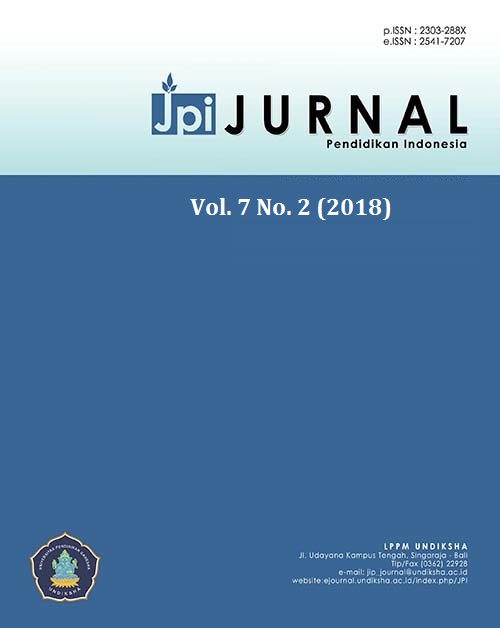Construction of Water Rocket Game Props for Science Learning in Primary Schools
DOI:
https://doi.org/10.23887/jpi-undiksha.v7i2.11721Keywords:
Props, Water Rocket, Learning Science for Primary SchoolAbstract
A water rocket is one of the simple types of props that comprise many science concepts. Manufacturing the water rocket is simple but every movement of water rocket launch needs high analysis. This research aims to design a scheme of water rocket props and to analyze the factors that affect the furthest distance of the water rocket launch. Some science concepts in the water rocket launch are examined. The results represent that throwing at a 45-degree angle produces the furthest distance. The shape of the water rocket's propeller is a trapezoid with a total of 3 propellers. The results also can be used as reference material for teachers in conveying science knowledge so the learning science will be more concrete and fun, especially in primary school.
References
Arsyad, A. 2002. Media Pembelajaran. Jakarta: Rajawali Pers.
Fitria, F.H., dkk. 2016. Konsep Fisika dalam Gerak Permainan Roket Air. Prosiding Seminar Nasional Pendidikan Sains (SNPS) UNS. Hlm: 245-254.
Haryani, F. F., Amaliah, R., Fitrasar, D., & Viridi, S. (2011). Konsep Fisika Dalam Gerak Permainan Roket Air. Seminar Nasional Pendidikan Sains. Surakarta.
Intan Irawati. 2016. Lomba Roket Air: Penerapan Pembelajaran Fisika Berbasis Proyek. Prosiding Seminar Nasional Fisika (E-Journal) SNF. Volume V, Oktober.
Ismail, N. 2015. The Integration of New Media in School: Comparing Policy with Practice. Universitas Sains malaysia, Penang Malaysia
Jamilah, S & Reza Oktiana A. 2016. Pengaruh Penggunaan Alat Peragga Aem (Algebraic Experience Materials)Terhadap KeterampilanBerpikir Kreatif Siswa Pokok Bahasan Operasi Bentuk Aljabar. Jurnal EduMa, volume 5 (1). Hlm: 91-99.
Muhamad Ijharudin. 2018. Pembuatan Roket Air Sebagai Media Pembelajaran Sains Untuk Siswa Sekolah Dasar. Jurnal Al-Khidmat. Vol 1, No 1.
Nurlaila, N., dkk. 2016. Pengembangan Media Mock-Up Pada Model Pembelajaran Latihan Penelitian di Sekolah Dasar. Pedadidaktika: Jurnal Ilmiah Pendidikan Guru Sekolah Dasar, Vol 3 (1). Hlm: 85-93.
Nuril, N.B., dkk. 2012. Rancang Bangun Alat Eksperimen Roket Air dari Barang Bekas sebagai Media Pembelajaran Mekanika. Prosiding Pertemuan Ilmiah XXV HFI Jateng dan DIY. Hlm: 186-189.
Pina Pitriana, Rena Denya Agustina, Rizki Zakwandi dkk. 2018. Fun Science: Roket Air Sebagai Media Edu-Sains untuk Meningkatkan Motivasi Belajar Peserta Didik Sekolah Dasar. JIPFRI (Jurnal Inovasi Pendidikan Fisika dan Riset Ilmiah). Vol 2, No 1. Halaman: 1-7 Edisi Mei.
Podesta, M.D. 2007. A Guide to Building and Understanding teh Physics of Water Rockets. National Physical Laboratory. Diunduh dalam http://www.npl.co.uk/upload/pdf/wr_booklet_print.pdf.
Trianto. (2013). Desain Pengembangan Pembelajaran Tematik. Surabaya: Kencana.
Untung Joko Basuki, Muhammad Sholeh, Joko Triyono. 2016. Pengenalan Teknologi Roket Air Pada Remaja Dan Anak-Anak Di Dusun Sembung Sendang Tirto Berbah Kabupaten Sleman. Jurnal Sains dan Teknologi. Vol 2 No 1.
Wilis, R.D. 1989. Teori-Teori Belajar. Jakarta: Erlangga.
Downloads
Published
Issue
Section
License
Authors who publish with the Jurnal Pendidikan Indnesia agree to the following terms:
- Authors retain copyright and grant the journal the right of first publication with the work simultaneously licensed under a Creative Commons Attribution License (CC BY-SA 4.0) that allows others to share the work with an acknowledgment of the work's authorship and initial publication in this journal.
- Authors are able to enter into separate, additional contractual arrangements for the non-exclusive distribution of the journal's published version of the work (e.g., post it to an institutional repository or publish it in a book), with an acknowledgment of its initial publication in this journal.
- Authors are permitted and encouraged to post their work online (e.g., in institutional repositories or on their website) prior to and during the submission process, as it can lead to productive exchanges, as well as earlier and greater citation of published work. (See The Effect of Open Access)








